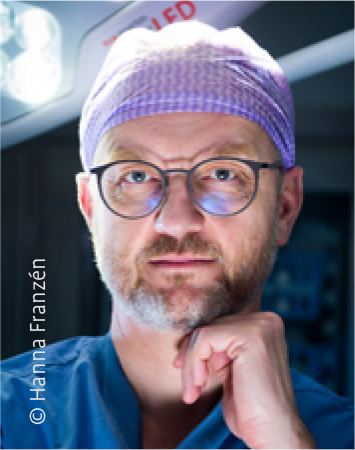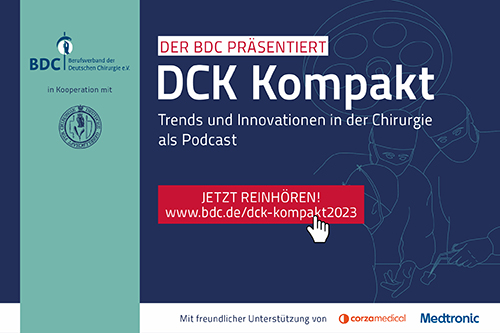01.06.2024 Fachübergreifend
BDC-Praxistest: Centralisation of surgery in Sweden

Vorwort – Zentrum oder Zentrale?
Liebe Kolleginnen und Kollegen,
die öffentliche Diskussion um die Bündelung medizinischer Leistungen birgt in Deutschland verschiedene diskursive Methodenfehler. Die wichtigsten Gründe dafür sind die Kenntnismängel führender Disputanten in den theoretischen Grundlagen argumentativer Debatten und ein wie immer in der Medizin vieles übertünchender, aber auch wie immer leicht zu erkennender Lobbyismus. So stolpern dann viele schon über den ersten Randstein – den Unterschied zwischen Zentrierung und Zentralisierung. Während das Zentrum Maßnahmen unter vielfältigen Erwägungen in Folge verbesserter Leistungen steigert, bündelt die Zentralisierung Ausführungen ex cathedra, damit die Qualität der Maßnahme folge. Natürlich werden Maßnahmen der Zentralisierung argumentativ unterfüttert, um die wissenschaftliche Erörterung zu überstehen. Hier zählt dann aber die Maßgabe „Less is more“, damit der anhängende politische Diskurs nicht mit zu vielen Parametern belastet wird. In Deutschland begrenzt sich so in der Medizin alles auf das Volume-Outcome. Wie dumm, denn schon ein simpler Blick über die Grenzen hätte schon geholfen, den Geist zu erhellen. Andere Länder in der EU haben diese Diskussion schon längst hinter sich.
Umso dankbarer waren wir, als die schwedischen Kollegen nach einer ganz intellektuellen, gemeinsamen Sitzung auf dem DCK 2023 zustimmten, ihre wertvollen Beiträge zur „Centralisation“ in Schriftform zu verfassen. Die Klaviatur wird in dem Beitrag so feingliedrig gespielt, dass wir neben dem englischsprachigen Original eine deutsche Übersetzung bieten. Das Thema ist zu wichtig.
Lehrreiche Lektüre wünschen
|
Prof. Dr. med. C. J. Krones |
und |
Prof. Dr. med. D. Vallböhmer |
 |
|
 |
The Swedish Surgical Society were honoured to be invited to the Deutscher Chirurgie Kongress in 2023. It was a great honour to be part of this congress and this is a summary of the session about centralization. Linus Axelsson, Chairman of the Swedish Surgical Association began with a background lecture.
Health care systems in Europe have a lot in common. Many struggle with shortage of staff, increasing health care costs and challenges concerning surgical training. However, comparing Germany and Sweden there are noticeable differences with implications for surgical care.
Sweden is 25 % larger than Germany, but only has 10 million inhabitants making Sweden a scarcely populated country. One might think that Sweden would have many rural hospitals to provide accessible health care, but that is not the case. In 1960 Sweden had 100 hospitals providing emergency care, but for various reasons such as shortage of staff, lack of funding or other political reasons half of these have closed or offer only elective care. Today there are 52 emergency hospitals providing 24/7 surgical care. Hence many swedes travel long distances for emergency care, 5 % of the population has more than 45 minutes travel time to emergency care, with or without access to acute surgery, in spite of optimal road conditions. Thus, Sweden has prioritized larger hospitals rather than short travel time, and on average a Swedish emergency hospital with surgical care has a catchment population of 200,000, although unevenly distributed.
Sweden is divided in self-governing regions concerning health care. Sweden has 21 regions with proper parliaments, that cooperate in 6 “health-care regions”, each with university hospitals. The regions have a national interest organisation, the Swedish Association of Local Authorities and Regions – SKR which is not a formal part of the Swedish governing structure. Formally, most decisions about health care are taken in the regional parliaments, but in reality SKR have a crucial influence on how Swedish health care is governed. The state regulates care mainly by laws, regulations and control authorities, but also decides upon national centralized care, which is a very small part of the health care.
Around ten years ago further centralisation of care in Sweden was discussed. Inspired by work by the leapfrog initiative in the US, and Denmark’s radical change of their health care system, both national politicians, SKR and parts of the profession wanted to focus cancer surgery to fewer high-volume centers. A later criticized government report stating that a lot of lives could be saved gave fuel to the change. The fact that there was scarce support for further centralisation in recent published studies in Sweden, nor data from our extensive registers supporting the radical changes proposed, mattered little. Proposals for what type of surgery that should be centralised where made by SKR supported supra-regional cooperations for cancer surgery, and the decision to follow these proposals were taken in all the regions.
Volume is a crucial factor for surgical quality but there are other factors to take into consideration.
First, there is the obvious question if it is the volume of the surgeon, his or her volume of a specific operation or his or her volume of all surgery or types of surgery that is close to the specific operation that matters, or if it is the volume of the hospital that is the most important factor. And what is the volume threshold? Is surgical specialisation important and how does that affect volumes? Is it the surgery or the perioperative care and handling of complications that matters most? With centralisation, will the quality of care provided decline at hospitals that no longer perform advanced surgery? Is advanced surgical care more available to patients living close to larger centres? All this probably matters when it comes to the outcome of a disease in a population. There are a lot of studies done trying to give these answers, but many uncertainties remain [1–9].
Another challenge for a hospital that loses a procedure will be to keep competent staff able to handle other conditions, for example advanced emergency surgery. Other patients might lose more than the patients with centralised surgery gain. In Sweden, where almost all emergency surgery is done by visceral surgeons that mainly work with elective surgery this is an obvious risk. Further, the transfer of patients and information between different units has risks [10].
The economy of centralisation is important. The hospital receiving the transferred patients are often reimbursed from the home region more than the actual costs due to marginal effects making receiving transfers profitable. A hospital that loses a patient group might need to reduce costs, but often this is demanding if you still need to provide service 24/7, you cannot just cut down 10 %. For many smaller regions in Sweden, there has been a rise in costs that partly is attributable to centralisation.
With all this said, what was the patient outcome of the latest round of centralisation? This far, we cannot see any substantial differences in outcome for operated patients in the centralised groups, but more research is needed to evaluate this. We know even less of the effect on a population level, which of course is the most important issue. But you also must consider that small hospitals nowadays are rare in Sweden. The centralisation was in an international perspective mainly from middle volume hospitals to a bit larger middle volume university hospitals.
Centralisation is in some circumstances necessary. Too low volumes lead to bad results, but the threshold is uncertain. The wide range of thresholds for adequate quality assurance differs from studies and countries implying that a true threshold may remain unknown. The optimal level of centralisation depends on many factors, and the negative effects on the health care given to the whole population must be considered, especially regarding emergency care. It is of great importance that the surgical community is involved in the plans for centralization, to address the challenges and avoid unnecessary conflicts.
David Edholm, surgeon at Linköping University Hospital, presented the Swedish centralization of esophageal and gastric cancer from 2007 and onwards. In 2007 esophageal cancer resections were done in 25 centres and gastric cancer resections in 50 centres. This has now been centralized to 7–8 centers. A slight improvement in long-term survival since 2007 has been noted but simultaneously neoadjuvant treatment has improved and minimal invasive surgery has been implemented which may affect survival. The evidence for centralization of esophageal resections is strong but the optimal volume remains uncertain and varies from studies. Regarding gastric cancer resections, a Swedish nationwide register-based study indicated that neither annual surgeon volume nor annual hospital volume of gastrectomies influences the long-term survival in gastric adenocarcinoma [11]. The results were adjusted for age, comorbidity, and tumor stage. With centralization, patients with non-malignant gastric condidtions may have difficulties receiving surgical care of high quality at rural hospitals no longer performing gastric cancer resections.
Pär Myrelid, also from Linköping University Hospital, presented data on centralisation within the field of surgical therapy of inflammatory bowel disease. This type of surgery is somewhat different from cancer surgery as the indications are less black or white compared to cancer surgery and also more focused on function and quality of life, especially restorative surgery after colectomy in ulcerative colitis. Data from England and Sweden has shown that only one third to just below half of the patients will have a restorative procedure after their colectomy, and the chance of having a restorative procedure is higher if the colectomy is performed at a high-volume center within IBD[12]. The data from Sweden has not been able to show a difference between low- and high-volume units when it comes to the risk of failure after a restorative procedure but this has clearly been shown in England and Denmark[13, 14]. In Denmark they forced hospitals to refer patients eligible for pelvic pouches to only five hospitals and could show a clear advantage when it comes to failure risk. Today they have made a change to only three units in Denmark, improving the outcome further. With this in mind, the European Crohn’s and Colitis Organization suggest an annual minimum of ten pouches in order to be a surgical IBD-center[15]. Apart from quality it also focuses on the importance of taking care of short- as well as long-term complications, research, improvement of care and training of future pouch surgeons.
Patrik Larsson, surgeon at Karolinska University Hospital, presented data from a Swedish national survey on surgical education. In this survey, all surgical departments answered questions on surgical education at their department. More than half of all surgical departments report that their residents had problems fulfilling the curriculum for surgical education. The main reason for this was a too small volume of many procedures, including basic procedures such as inguinal hernia repair and cholecystectomies, and also a lack of some procedures at their hospitals. The experience from many departments was that the centralisation that had taken place the last decade had accelerated this problem. Moreover, many experienced that in the process of centralisation the surgical education had not been taken into account in their region.
Finally, one should consider Birkemeyer’s conclusion after studying the effect of centralisation in the US. „For most high-risk procedures, however, strategies such as operating-room checklists, outcomes-measurement and feedback programs, and collaborative quality improvement initiatives are likely to be more effective than volume-based referral” [16]. The tradition in Sweden of doing this might explain why Sweden has good surgical results despite lacking high volume centres.
Literatur
[1] Dimick, J.B, et al., Measuring Surgical Quality: What is the Role of the Provider Volume? World J. Surg., 2005. 29 1217–1221
[2] Fischer, C., et al., Volume-outcome revisited: The Effect of hospital acnd surgeon volume on multiple outcome measures in oesophago-gastric cancer surgery. PLoS One. 2017 Oct 26;12(10)
[3] Dikken, J.L., et al., Differences in outcome of esophageal and gastric cancer surgery across Europe. BJS, 2013. 100: p. 83–94.
[4] Ghaferi A.A., et al., Hospital Volume and Failure to Rescue With High-risk Surgery. Medical Care, 2011. 49(12): p. 1076–1081.
[5] Funk, L.M., et al., Esophagectomy Outcomes at Low-Volume Hospitals, The Association Between System Characteristics and Mortality. Annals of Surgery, 2011. 253(5): p 912–917
[6] Liedberg, F., et al., Period-specific mean annual hospital volume of radical cystectomy is assosiated with outcome and perioperative quality of care: a nationwide population-based study. BJU 2019. 124: p. 449–456
[7] Sahni, R.S., et al., Surgeon specialisation and operative mortality in United States: retrospective analysis. BMJ 2016. 354: i3571
[8] Hindenburg, T., et al., No reduction in mortality after centralisation in treatment of patients with ruptured abdominal aneurism. Dan Med J 2019. 66(7): A5551
[9] Varagunam, M., et al., Changes in volume, clinical practice and outcome after reorganisation of oesophago-gastric cancer care in England: A longitudinal observational study EJSO 2018. 44: 524–531
[10] Murshed, I., et al., Surgical interhospital transfer mortality: national analysis. BJS 2023. 110: p. 591–598
[11] Asplund, J., et al., Annual surgeon and hospital volume of gastrectomy and gastric adenocarcinoma survival in a population-based cohort study. Acta Oncologica, 2022. 61(4): p. 425–432.
[12] Worley, G., et al., Restorative surgery after colectomy for ulcerative colitis in England and Sweden: observations from a comparison of nationwide cohorts. Colorectal Dis, 2018. 20(9): p. 804–812.
[13] Burns, E.M., et al., Volume analysis of outcome following restorative proctocolectomy. Br J Surg, 2011. 98(3): p. 408–17.
[14] Mark-Christensen, A., et al., Pouch failures following ileal pouch-anal anastomosis for ulcerative colitis. Colorectal Dis, 2018. 20(1): p. 44–52.
[15] Oresland, T., et al., European evidence based consensus on surgery for ulcerative colitis. J Crohns Colitis, 2015. 9(1): p. 4–25.
[16] Finks, J.F., et al., Trends in Hospital and Operative Mortality for High-Risk Surgery. N Engl J Med, 2011. 364(22): p. 2128–2136.

Linus Axelsson
Chairman, Swedish Surgical Society
Senior Consultant
Department of Surgery
Blekinge County Hospital
Sweden
Gesundheitspolitik
Axelsson L: BDC-Praxistest: Centralisation of surgery in Sweden. Passion Chirurgie. 2024 Juni; 14(06/II): Artikel 05_01.
Weitere Artikel zum Thema
01.10.2023 Digitalisierung
Wie die Digitalisierung der Chirurgie den Weg für Künstliche Intelligenz ebnet
Die in Deutschland angestrebte Digitalisierung des Gesundheitswesens verspricht vereinfachte Arbeitsabläufe, effizientere Kommunikation sowie bessere Dokumentation und daraus folgende sicherere Handlungsabläufe [1]. Diverse digitale Gesundheitsanwendungen wie beispielsweise die elektronische Patientenakte (ePA), ermöglichen es, Patienten und medizinischem Personal einen gesammelten Überblick über die dem Patienten zugehörigen Dokumente zu verschaffen.
01.10.2023 Ambulant
BDC-Praxistest: Fit statt schlapp – präoperative Sporttherapie
Es kann davon ausgegangen werden, dass die Fitness von Patienten und Patientinnen zum Zeitpunkt der Operation eine Rolle für den postoperativen Verlauf hat, sodass sie mit einer geringeren Fitness ein höheres Risiko für postoperative Komplikationen haben. Dies hat zur Frage geführt, inwieweit die Fitness und im Weiteren die funktionelle Kapazität präoperativ verbessert werden können.
01.04.2023 Fachübergreifend
Versorgung von chronischen Wunden in der chirurgischen Praxis
Der hier dargestellte Organisationsablauf kann und soll nur eine Möglichkeit der Organisation sein, selbstverständlich ist dieser nur auf unsere Praxis zugeschnitten, kann und muss auf die individuellen Gegebenheiten vor Ort angepasst werden. Es soll hier keine dogmatische Darstellung erfolgen.
Lesen Sie PASSION CHIRURGIE!
Die Monatsausgaben der Mitgliederzeitschrift können Sie als eMagazin online lesen.






















